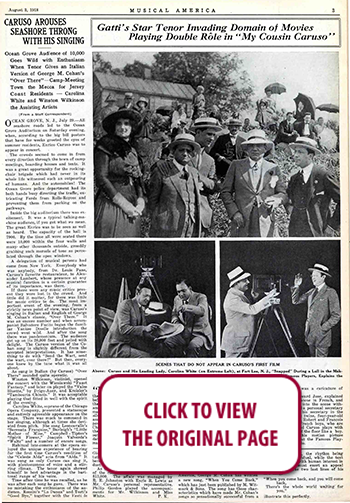 100 YEARS AGO IN MUSICAL AMERICA (251)
100 YEARS AGO IN MUSICAL AMERICA (251)
August 3, 1918
Page 3
CARUSO AROUSES SEASHORE THRONG WITH HIS SINGING
Ocean Grove Audience of 10,000 Goes Wild with Enthusiasm When Tenor Gives an Italian Version of George M. Cohan’s “Over There”—Camp-Meeting Town the Mecca for Jersey Coast Residents—Carolina White and Winston Wilkinson the Assisting Artists
[From a Staff Correspondent] OCEAN GROVE, N.J., July 29.—All seashore roads led to the Ocean Grove Auditorium on Saturday evening, when, according to the big bill posters that have for weeks greeted the eyes of summer residents, Enrico Caruso was to appear in concert.
The crowds seemed to come in from every direction through the town of camp meetings, boarding houses and tents. It was a great opportunity for the rocking-chair brigade which had never in its whole life witnessed such an outpouring of humans. And the automobiles! The Ocean Grove police department had its both hands busy directing the traffic, extricating Fords from Rolls-Royces and preventing them from parking on the pathways.
Inside the big auditorium there was excitement. It was a typical talking-machine audience, if you get what we mean. The great Enrico was to be seen as well as heard. The capacity of the hall is 7900. By the time all were seated there were 10,000 within the four walls and many other thousands outside, greedily grabbing such morsels of tone as percolated through the open windows.
A delegation of musical persons had come from New York. Everybody who was anybody, from Dr. Louis Pane, Caruso’s favorite restaurateur, to Alexander Lambert, whose presence at any musical function is a certain guarantee of its importance, was there.
If there were any music critics present they were lost in the crowd. And little did it matter, for there was little for music critics to do. The most important event of the evening, from a strictly news point of view, was Caruso’s singing in Italian and English of George M. Cohan’s classic, “Over There.” It was an encore number and when accompanist Salvatore Fucito began the familiar Yankee Doodle introduction the crowd went wild. And after the song there was pandemonium. The audience got up on its 20,000 feet and yelled with delight. The Caruso version of the Cohan song is slightly different from the accepted interpretations. It has something to do with “Send the Wart, send the wart, over there!” But then, everyone knew by the tune what it was all about.
As sung in Italian (by Caruso) “Over There” sounded quite operatic.
Winston Wilkinson, violinist, opened the concert with the Wieniawski “Faust Fantasy,” and later on played the “Valse Bluette,” by Drigo-Auer, and Kreisler’s “Tambourin Chinois.” It was acceptable playing that fitted in well with the spirit of the evening.
Carolina White, soprano of the Chicago Opera Company, presented a statuesque and entirely agreeable appearance on the stage. There was much to commend in her singing, although at times she deviated from pitch. She sang Leoncavallo’s “Serenata Française,” Burleigh’s “Little Mother of Mine,” Campbell-Tipton’s “Spirit Flower,” Joaquin Valverde’s “Waltz” and a number of encore songs.
Habitual late-comers at the opera enjoyed the unique experience of hearing for the first time Caruso’s rendition of the “Celeste Aida” aria from “Aida.” It was sung as only Caruso can sing it, with plenteousness of voice and a stirring climax. The tenor again showed himself to best advantage in the baritonal range of his voice.
Time after time he was recalled, as he was after each song he gave. There was no mistaking the enthusiasm of the audience. Rossini’s “La Danza” and Tosti’s “Good Bye,” together with the Vesti la Giubba aria from “Pagliacci,” constituted his remaining programmed numbers, in addition to the encores and a duet from Gomez’s “Il Guarany.”
As to the vital statistics, the receipts of the concert amounted to more than $13,000. The affair was managed by R. E. Johnston with Earle R. Lewis as Mr. Caruso’s personal representative. Philip Gordon played the accompaniments for Mr. Wilkinson and Miss White. —P. K.
Gatti's Star Tenor Invading Domain of Movies Playing Double Rôle in “My Cousin Caruso”
“My COUSIN CARUSO.” That intimate little phrase will be on the lips of every American movie-lover before many weeks slip by, for has not the Metropolitan Opera’s generalissimo among tenors entered the inviting domain of Film? In the latter, where silver throats are merely an indirect asset, he will pit his histrionic powers against the formidable Fairbanks, Chaplin, Hart, etc. Here is an idea of the plot of the film in which Caruso sets out to conquer new worlds, and a few data concerning the picture and its making.
The story, which is called “My Cousin Caruso,” concerns the life of a poor artist, Pietro Caroli (although this name may be changed .before the picture is finished). This artist endeavors to make a “hit” with his girl by pretending to be a cousin of Caruso. Caruso plays both parts—himself and the artist.
The first scene taken shows Caruso as himself sitting at his own desk, which is fitted with his own desk ornaments brought up to the Famous Players studio. His leading woman will be Carolina White, the opera singer. The sketch, which Caruso drew while the first scene was being taken, was a caricature of himself.
The director, Edward Jose, explained the action of the scene in French, and Caruso went right into the scene without a rehearsal. His personal secretary plays the part of his secretary in the picture. There are twins, four-year-old boys, in the picture, Robert and François Michel, two little French boys, who are gifted tumblers, and Caruso plays with them, rolling around the floor like a boy.
Caruso began his motion picture career on July 18 at the Famous Players New York Studio.




 RENT A PHOTO
RENT A PHOTO





